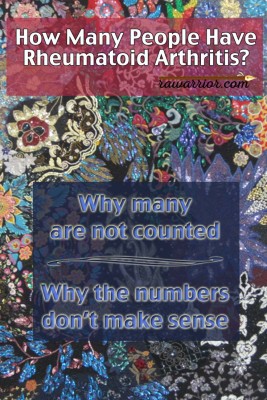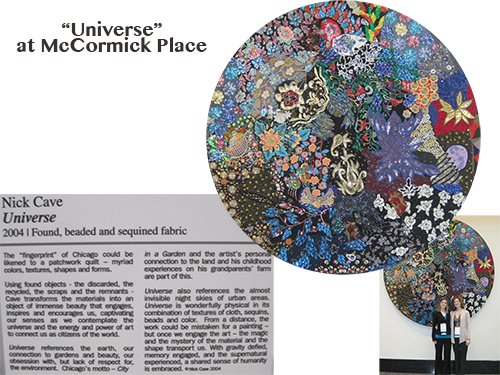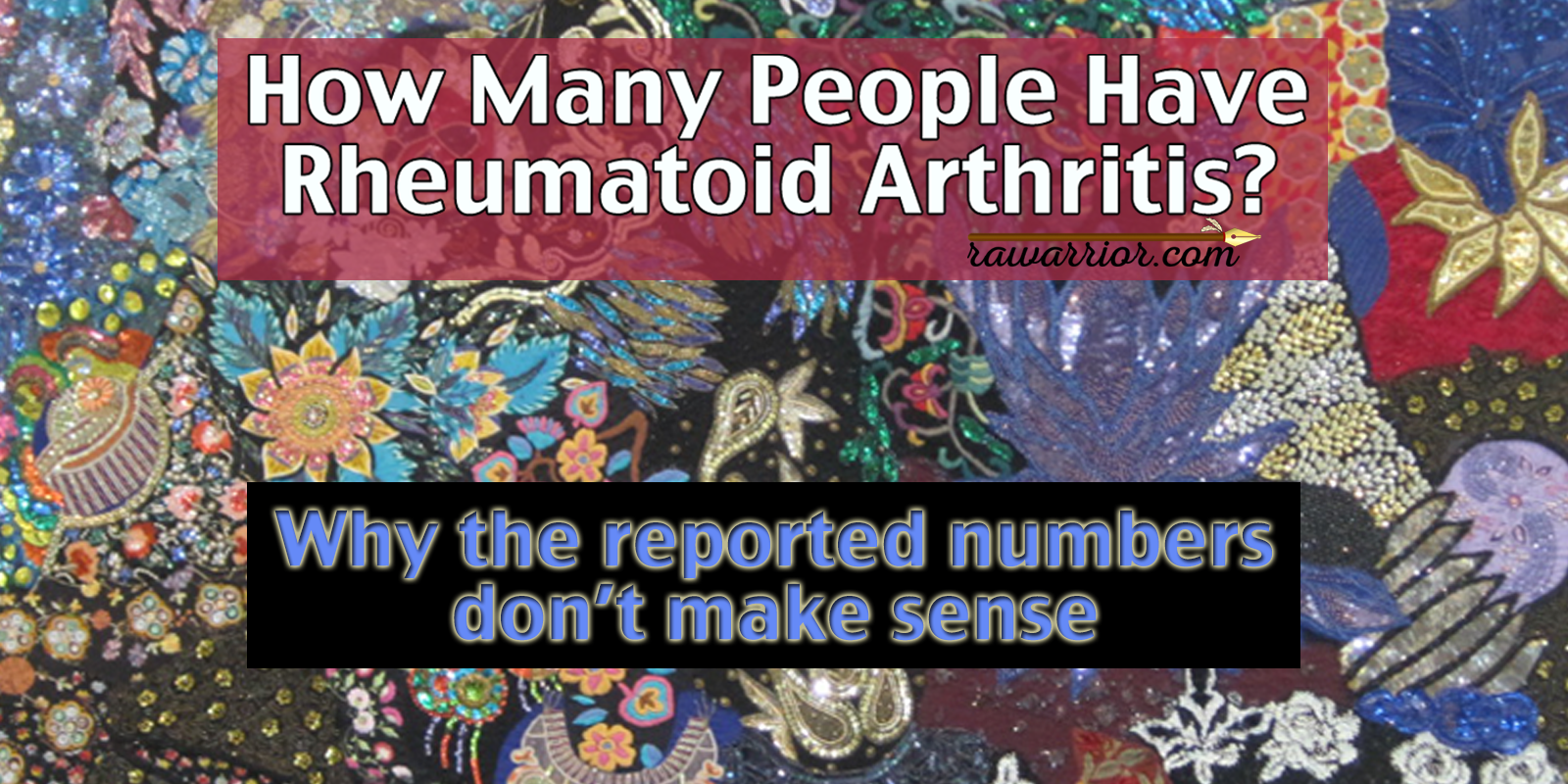How Many People Have Rheumatoid Arthritis?
Counting how many people have Rheumatoid Arthritis (UPDATED)
Do we know for sure actually how many people have rheumatoid arthritis? How many are being treated for RA in the U.S.? Or how likely a person is to be diagnosed with RA in his or her lifetime?

Not really. Apparently, it’s a slippery target.
In 2009, Gabriel and Michaud indicated that “a recent systematic review of the incidence and prevalence of RA revealed substantial variation in incidence and prevalence across the various studies and across time periods within the studies,” Arthritis Research & Therapy (emphasis added). In that study, they reported a suspected decline in the incidence of RA. However, a year later, Mayo Clinic reported that the incidence of RA in the U.S. was actually climbing. Publications from Mayo Clinic have estimated between 1.6 and 2.1 million in recent years.
This chart from 2011 shows lifetime risk of Rheumatoid Arthritis and similar diseases.
– The Centers for Disease Control and Prevention (CDC) lists RA on its “arthritis” page of its data section. According to CDC, an estimated 1.5 million adults had rheumatoid arthritis in 2007.
– The American College of Rheumatology regularly estimates the number of Americans with RA at 1.3 million.
– Other organizations consistently say “more than a million” in the U.S. have RA.
How can we know how many people have Rheumatoid Arthritis?
There are 3 ways we could estimate how many people have Rheumatoid Arthritis.
1) Deciding how many by GENETICS
“2.4 out of 100 men of European ethnicity will get Rheumatoid Arthritis between the ages of 18 and 79.”
23andMe estimates genetic risk for many diagnoses, including Rheumatoid arthritis. 23andMe estimates the genetic risk of RA to be 2.4% for men and 4.2% for women (of European ancestry). That’s easy to remember. But genetic risk is only half of the story. Literally.
Researchers hypothesize that environmental triggers account for about 50% of the risk of developing RA. So we might expect only those with the genetic risk who are also exposed to certain triggers to actually develop the disease. This is a logical explanation for the variance in incidence across time periods.
If genetics vary somewhat, and environment varies also, there should be variance in how many people have RA.
2) Using DIVISION to figure how many people have Rheumatoid Arthritis
According to the World Heath Organization (WHO), “the prevalence of definite or classical RA by the 1958 ARA or 1987 ACR criteria is approximately 1%.” This is a significant statement since those older diagnostic criteria allow for diagnosis of more advanced disease, which means fewer people were diagnosed.
How many people are in the U.S.? 322,857,857 – according to the U.S. Census Bureau’s Population Clock. One percent of roughly 320 million is over 3 million.
3) COUNTING how many people have Rheumatoid Arthritis
Raise your hand high so we can see you in the back. Ouch. Maybe not.
It’s obviously not feasible to count everyone with rheumatoid disease, but even extrapolating from a smaller population is problematic.
Many people with rheumatoid disease would not be counted:
- People often have symptoms for a long time before being diagnosed with RA.
- Many give up and quit seeing rheumatologists or taking treatments.
- For a complete statistical picture, we need to include those diagnosed in childhood. 300,000 are estimated to have JRA / JA in the U.S., and adults diagnosed with RA commonly report symptoms extending back into childhood.
Statistics means never having to say you’re certain.
Postblog: are statistics good or evil?
“There are three kinds of lies: lies, damned lies, and statistics.” Popularized by Mark Twain, it still rings true today, but statistics don’t always intend to lie. And people actually like statistics when they can be used to prove a point.
Statistics are actually a valuable tool. I read a remarkable article on stats this week, in terms of basketball. An excerpt: “…The NBA is like a 24-hour statistical buffet nowadays. It can’t be ignored… Stats are here to stay. Showing up without them is like a carpenter showing up to work without a hammer. But statistics are a tool, not the tool. The carpenter needs a hammer, but you can’t just go around hammering everything and calling it good.”
No, statistics are not the only tool to help people with rheumatoid disease (RD). But we need to have more accurate estimates in the future so that we can advocate for people living with RD, however many of them there are.
EDIT April 2013: Note: Hospital for Special Surgery in New York recently estimated that 3 million people in the U.S. have Rheumatoid Arthritis.
Hospital for Special Surgery. Hospital for Special Surgery receives grant for new genomics center to study autoimmune diseases. 2013 Apr 25 [cited 2013 May 16]. Available from: http://www.hss.edu/newsroom_genomics-center-study-autoimmune-diseases.asp
EDIT Jan 2016: A recent Oxford Journal research article notes the 1% prevalence of rheumatoid is expected to rise during the next 20 years, possibly to over 20% due to an aging world population.
RA: from risk factors and pathogenesis to prevention. 2015 Sep 15 [cited 2016 Jan 22]. Available from: http://rheumatology.oxfordjournals.org/content/early/2015/09/14/rheumatology.kev347.full
Edit 2014: Developer of new rheumatoid drug says 3 million have RA in the U.S.
http://www.argentisrx.com/content/show.asp?mne=pipeline NOTE: As of 1/22/2016, Argentis Rx has deleted this page from their site.






Interesting. Not all that surprising is it? I’ve heard many stories of people having symptoms but their Dr is unable to diagnose for a variety if reasons… In my case, the diagnosis was definitive but it was done after some anomalies post-surgery. Had I not gone under the knife, would I have been diagnose already?… After I was diagnosed looking back on my life, RA explained a lot of things. Many times I shrugged things off and blamed them on wear and tear of my body, as well as simple old age or as my Primary likes to call it , all the mileage I’d put on my body…
Thanks for sharing the article and your thoughts Kelly. As always, I enjoyed it.
José
I got obsessed with this question last year. If the “official”stat is 1.3 million, but at the same time it’s estimated that 1% of the population has RA, there’s something wrong. I suck at math, but even I can see there’s a problem. I spent some time trying to find the origin of the 1.3 million number – CDC, maybe? – and eventually gave up. It was a rabbit hole.
This is something Ive been thinking about, it seems since Ive learned I have RD, everytime I turn around someone will tell me this person or that person has RD. The thing that bothers me is that these people they are talking about always seem to be very active and like its no big deal. Ive been so bothered because I have never encountered so much pain in the last maybe 8 months,I find regular life to be very difficult. I was dx with sjorens probably 5 years ago, along side with RA and sjogrens Ive been dx’d with udctd. So here it is I feel like I must be doing something wrong that my pain is constant and disruptive to my life. I’m writing this with a very heavy heart. Thanks that I have some place to write my feelings. Kelly you are a blessing.
Bonnie, I hope it helps you some to know that your experience is common. The things people say to you about knowing someone with mild RA, the amount of pain you experience, the way this disease disrupts your life – these are all things people write me about frequently. You’re definitely not alone.
What about those people you’re told about so often who just continue as if they are not ill? When people with a single inflamed joint or periodic symptoms in several joints are diagnosed, they may have no idea what it is like to live with constant disease or many joints affected. So they may mostly carry on a normal life and still carry the same label of “RA” that you do. But it’s a very different experience from the “constant and disruptive” RA you live with. The range from mild to severe seems extremely broad.
Another thing to remember is that your friends who tell you these things may not really know how much RA has affected the other person they know. Commonly, people are pretty private about RA, so perhaps those folks are struggling more than others realize.
At 1% of the population, this is a common disease. There are many on both fringes I think – from those who no longer see doctors because the drugs didn’t help, to those who are undiagnosed because their symptoms do not fit the models or are palindromic (periodic).
Bonnie – I have what my rheumy would call moderate RA and much the same as you find in hugely distruptive and painful. If you have severe RA it can get much much worse. Some people have relatively mild symptoms that are well controled. But as Kelly has said, it can be hard to tell. Even now, when I have finally achieved some very good control, I find myself very much behind the curve. When my colleges at work walk across the street for lunch, I lag way behind, unable to maintain their pace. I tire easily and quickly. I cut the corned beef, with an electric knife, for St. Paddy’s day, and my wrist hurt so much I was forcing myself to finish. I had to stop twice. But I can do it now where I couldn’t do it before. Today I can open a bottle of water. Before Humira, I couldn’t. Do I share this with my work mates or friends? Not if I don’t have to. You might not be aware of how much pain these people may be experiencing. I feel that if I share this I would just be complaining all the time – who wants to hear that?
Bonnie, i had a cousin, she was like a sister to me. She had severe RA, in the 70’s was when she was diagnosed, her sed rate was thru the roof, over a 100, positive on all the other markers they used. She had deformed fingers and feet, had both ankles fused, both hands done, both hips done twice and both knee replacements. To many people including my mom, she never complained or said how she was really feeling. She stayed very active in church and in her daughters school acitivities. So maybe some that we meet or we hear about is having bad days as we are, they just don’t speak about it. She was my mentor when I was diagnosed in 1995. She passed away this past November, but I will always remember she shared with a few close family members and friends, but never in public. She always had a smile even when she felt like crying. We would vent to each other and know that the other understood where the other was coming from.
Hello. I was diagnosed by a Physicians Assistant .I wonder does this show up in the stats. or is it only when a RA doc confirms the diagnosis?
If they prescribe treatment for it and it’s coded as RA, then it would be counted even if the practitioner is not an MD. I don’t think anyone has counted though, really – it’s all estimates based on counting smaller portions.
Interesting. I have no genetic background and no environmental triggers either. Just the genetic jackpot, I guess. My symptoms were text book when they arrived last year. I am normal, but not the norm? 🙂
I suppose so Kim. 😉
There are 15.Million people with Rheumatoid Arthritis in the US
Please! make the change to tell People they need know how many people suffer every day!!
I really don’t know why I’m writing this because I know I will not help the situation. But I was diagnosed with rheumatoid arthritis in 2008 but had suffered the pain for three years prior to that but couldn’t find a doctor that would listen to the symptoms and the pain I was going through.
Finally my daughter found someone that did the test and discovered my problem. Because I’m on a blood thinner ruled out NSAIDS so she used the alternative.
It was a blessing to get some relief from the pain I had suffered so long. Although there is always the constant pain, its not like it was before. I can at least walk although very slowly and occasionally fall. I moved from Georgia to Alabama recently and had to change pain clinics. I had attended the one in Georgia for over seven years and went through many injections, epidurials ect.. The last was the three bilaterial knee injections which didnt help at all.
My daily activities are very limited and my new pain management doctor told me the other day he was going to start tapering off my treatment. I have a daughter that is a doctor and she says they have me on the very minimum at this time and this one is talking about tapering them down even more.
If that happens I won’t even be able to walk and I’ve been there before and don’t want to go back. I think I’ve talked to much already, so I’ll stop now. Thanks for listening.